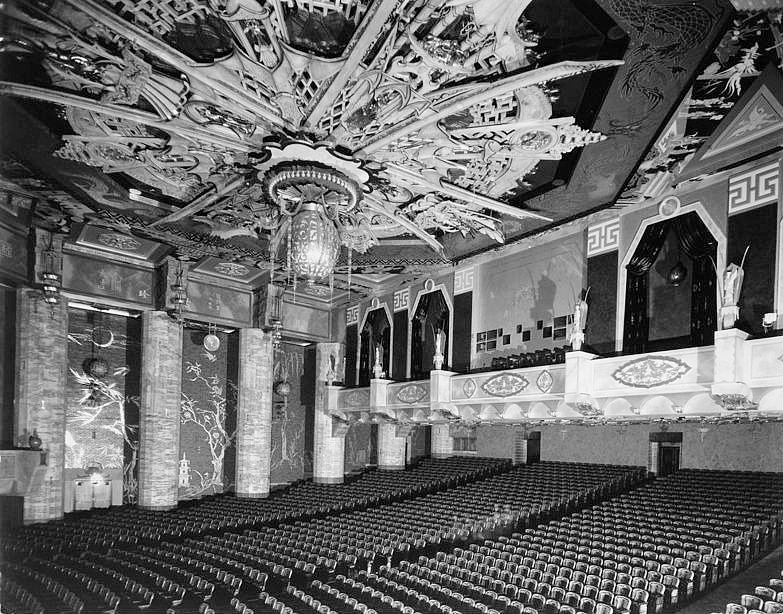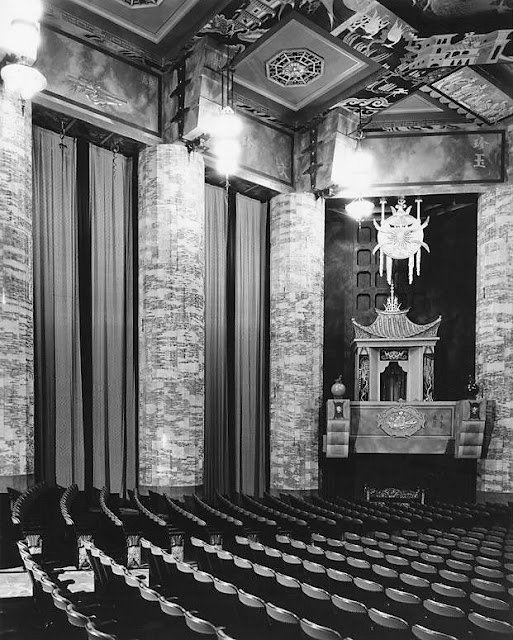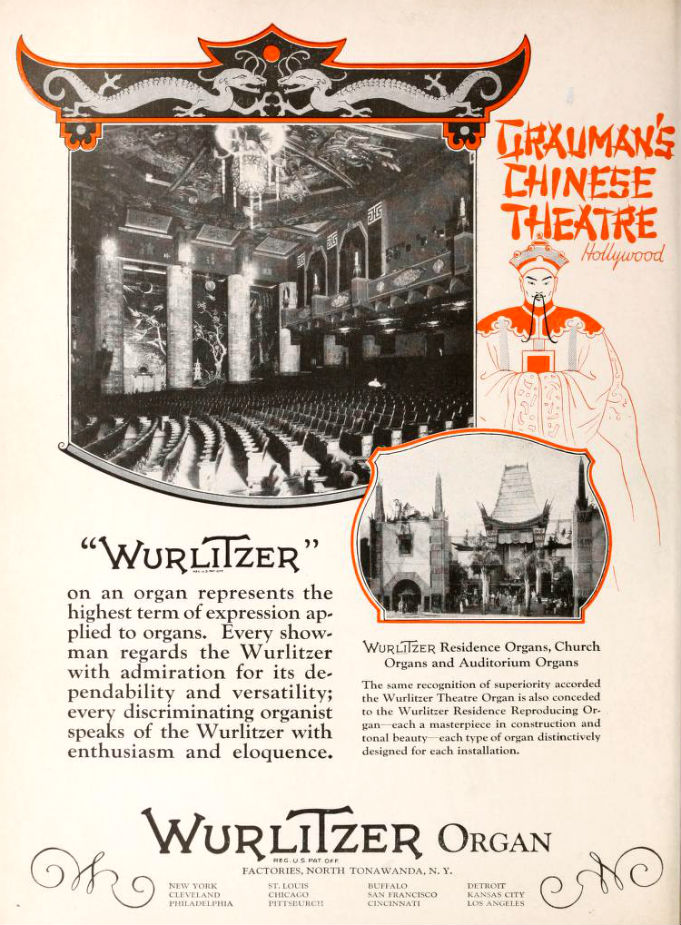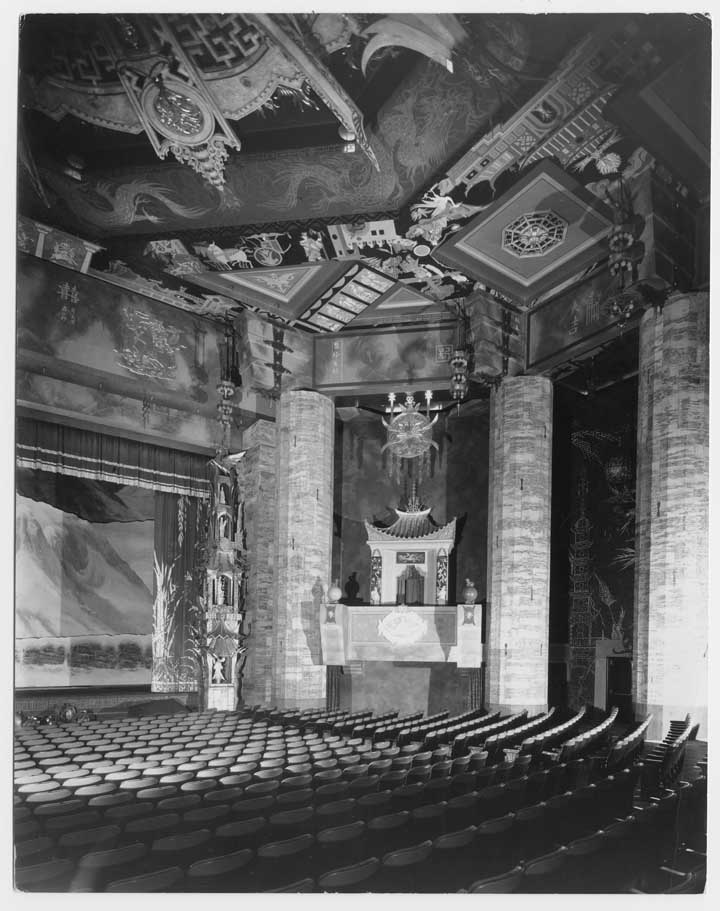Grauman's Chinese Theatre
Hollywood Blvd.
Los Angeles: Hollywood, CA
Note: Not extant. Not playable. (in this location)
Images
 1927 - Chinese Theatre Auditorium (Photograph from an archival source: Mott Studios--1927 via The California State Library Collection, submitted by Eric Schmiedeberg/Eric Schmiedeberg)
1927 - Chinese Theatre Auditorium (Photograph from an archival source: Mott Studios--1927 via The California State Library Collection, submitted by Eric Schmiedeberg/Eric Schmiedeberg) 1930 - House-left pagoda box. (Photograph from an archival source: Mott Studios--c. 1930 via The California State Library Collection, submitted by Eric Schmiedeberg/Eric Schmiedeberg)
1930 - House-left pagoda box. (Photograph from an archival source: Mott Studios--c. 1930 via The California State Library Collection, submitted by Eric Schmiedeberg/Eric Schmiedeberg) 1926 - Wurlitzer Organ Company advertisement (Photograph from an archival source: Unknown. , submitted by Eric Schmiedeberg/Eric Schmiedeberg)
1926 - Wurlitzer Organ Company advertisement (Photograph from an archival source: Unknown. , submitted by Eric Schmiedeberg/Eric Schmiedeberg) c.1930 - Console (Photograph from an archival source: Jim Lewis collection, submitted by Jim Lewis/Jim Lewis)
c.1930 - Console (Photograph from an archival source: Jim Lewis collection, submitted by Jim Lewis/Jim Lewis) Unknown - Theater Interior (Photograph by Mott Studios ca. 1927 via California State Library/Database Manager)
Unknown - Theater Interior (Photograph by Mott Studios ca. 1927 via California State Library/Database Manager)
Consoles
Main (House right in pit), Dummy (House Left in pit)
- Organ type: Horseshoe
- Console position: Console in Fixed Position, Right
- 3 manuals
- 134 registers
- 3 divisions
- Key action Type: Electrical
- Stop action Type: Electrical
- Stop layout Type: Stop Keys in Horseshoe Curves
- Manual compass: 61 notes
- Pedal compass: 32 notes
- Pedal Type: Concave Radiating (Details Unknown)
- Expression Type: Balanced Expression Shoes/Pedals (Details Unknown)
- Has crescendo
- Combination action: Setterboard
- Wurlitzer Electro-Pneumatic
- Has combination thumb pistons
- Has combination toe pistons
Notes
2012-08-20 - Identified through online information from Jim lewis. -- Three manual Style 260SP. Pipework was in a chamber on the roof and spoke through an elaborate Chinese-style ceiling grill. 32' octave of the Diaphone was behind the box seating on the west side of auditorium. Console was finished in ebony and had gold dragons painted on either side of the keydesk. In 1959 the organ was removed and installed in St. Finbar's Catholic Church, Burbank, CA. It was removed c. 1990 and parted out. -Database Manager
2012-12-25 - Updated through online information from Will Dunklin. -- Style 260 Special. Original cost $26,879.04 -Database Manager
2022-06-11 - I have examined the theatre architect's blueprints of this theatre and some things came to light by doing so. Firstly, neither the orchestra pit nor either one of the organ consoles are serviced by lifts. Secondly, there are two areas designated for "pipes" which are rather shallow and long. These locations are against the back walls of the areas behind each pagoda balcony at house left and right. The spaces reserved for "pipes" are indicated by boxes with dashed lines. There appear to be tone slots for these spaces located near the ceiling of the pagoda alcoves in photographs. All of this would strongly suggest that the 12-pipe 32' octave of the Diaphonic Diapason was split between these two areas and that tonal egress was mainly from the aforementioned slots. I say "mainly" because the powerful and penetrating low frequencies that these pipes produced would have found their way into the auditorium in numerous ways. Indeed, the spaces they occupied were not under expression. Given the size of the Chinese auditorium, these pipes must have made QUITE the statement in that space.....well, throughout the entire theatre for that matter! Go to YouTube and search for "32' Diaphone pipes". There are at least two interesting videos there that will show you these monsters and what they sound like. It should be noted, however, that those pipes are a Wurlitzer 6-pipe "trap door" set. My understanding is that the Chinese organ had a typical 12-pipe set as only the Wurlitzers in the United Artists Theatres of Detroit and Los Angeles are known to have had these special sets. However, the UA and Chinese 32's were of "Style 260" scale and probably operated on similar pressures. "Urban legend": The 32's at the UA in LA popped light bulb filaments when used and were permanently disconnected at some point! The pagoda balconies and original proscenium arch of the theatre were demolished in 1958 when the super-widescreen craze began. The organ console was disconnected at this time to make way for a new concrete slab poured over the original orchestra pit floor As a result of all of this, a lot of the original Chinese architecture in the auditorium was lost.
It has always seemed odd to me that the theatre pipe organ that was installed in what is arguably the most famous theatre in the world has been given so little attention by historians and "organ people". Hopefully, my research and the internet links I have provided will help "fill in some blanks".
The only thing I remember reading about the Chinese organ is that Gaylord Carter had said that the organ had a good sound and that the Color Reeds were especially nice in combination with some of the organ's other voices. George Wright had stated that the organ had a good--and somewhat "distant"--sound in the auditorium. No doubt this was due to the fact that the organ had to speak through a long tone chute that lead to the elaborate ceiling grille located in the middle of the ceiling. This put the partially-blocked tonal egress of the expressive portions of the organ well behind the organist in the orchestra pit. One must wonder whether the whisper-soft Dulciana in that organ was really just a waste of space and metal!
-Eric Schmiedeberg
2022-06-11 - Missing info; and correcting info based on archetect's blueprints -Eric Schmiedeberg
2022-07-04 - My comments about the placement of the 32' Diaphone pipes in this instrument should be disregarded. Upon further investigation, it would appear that I erred in my reading of the Chinese plans. Looks like Jim Lewis's comment about their placement will have to stand as the best one available here. -Eric Schmiedeberg
2022-07-04 - It should be noted that the Chinese instrument had but one chamber under expression. This is highly unusual for a Style 260 Wurlitzer. Normally, this model would have had at least two. Every Wurlitzer organ chamber layout I have seen located as a proscenium or tone chute installation has had at least two expressive chambers. These layouts being originally for a 3/8 and two 3/13's. -Eric Schmiedeberg
2022-07-04 - Correcting chamber layout. The Chinese organ was contained in one room only. Unusual for a Style 260 Wurlitzer that would normally have at least two -Eric Schmiedeberg
Websites
Other Links
Regrettably, it is not possible to display the information about the sponsor of this pipeorgandatabase entry or if there is a sponsor. Please see About Sponsors on Pipe Organ Database.




